Ten years before the “New Math,” 144 was equal to 225, at least for one day. The occasion was a December 1956 Chicago fantrip, using one of the last surviving Red Pullman streetcars.
Red Cars were phased out of regular service by CTA in 1954, and nearly all were scrapped soon after, but a few were kept, including cars 144, 225, and 460. Today 225 is at the Seashore Trolley Museum in Maine, while the other two are at the Illinois Railway Museum. Car 144 was one of the first purchases made by the fledgling museum, now celebrating its 60th year, and 460 was stored for decades as part of the CTA historical collection before it too found its way there.
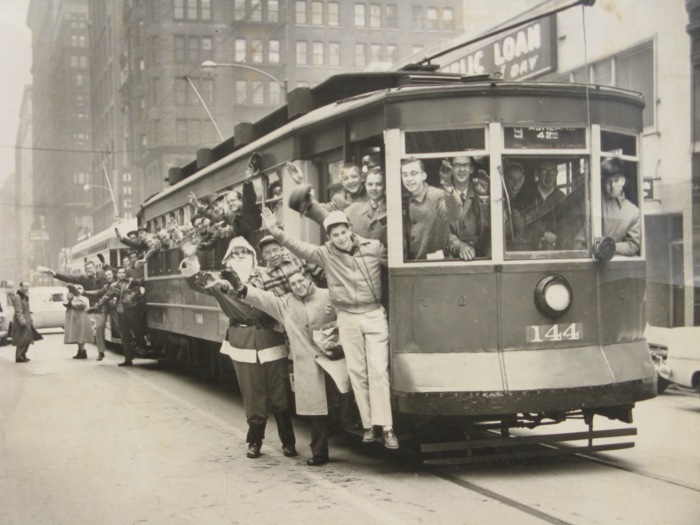
CTA #225 masquerading as 144, on an Illini Railroad Club fantrip in December, 1956 (George Foelschow collection). Location is on Dearborn near Washington.
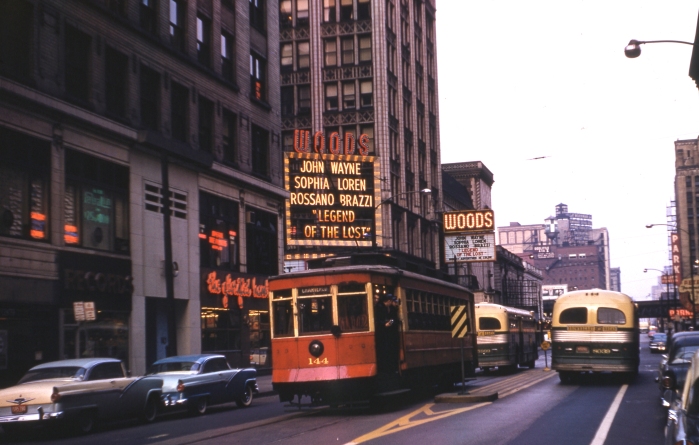
CTA #144 on an Illini Railroad Club fantrip in December, 1957. We are looking north on Dearborn Street near Randolph. We see buses here since by this time, PCCs did not run on weekends on the #22 Clark-Wentworth line. (Author’s collection)
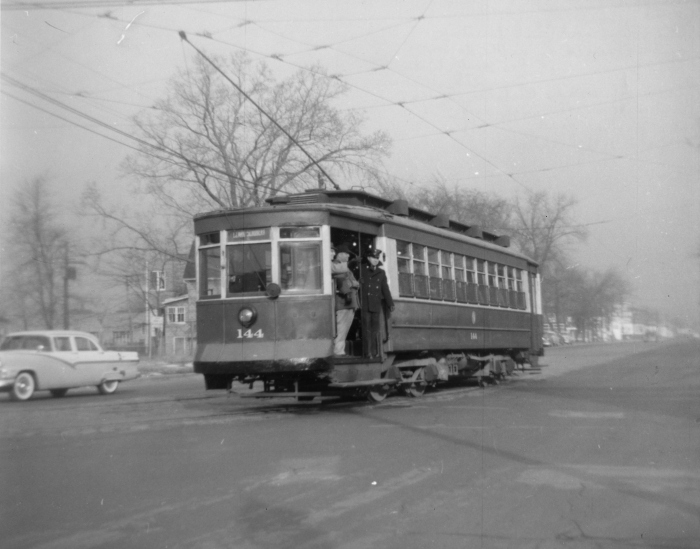
CTA #144 on the 12-29-57 fantrip, at 81st and Vincennes, on Vincennes Avenue looking north (Author’s collection)
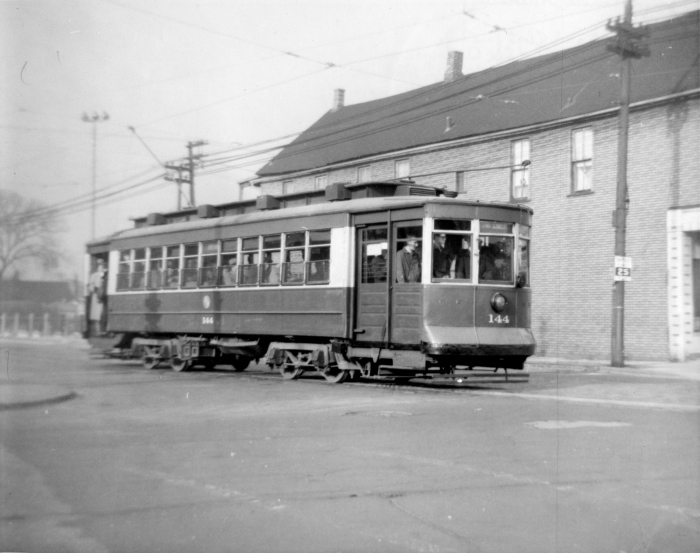
#144 at the intersection of 81st and Vincennes, on the 12-29-57 fantrip (Author’s collection)

144 northbound on Dearborn, on the 12-29-57 fantrip (Author’s collection)

CTA #144 in regular service, at the west end of the 63rd Street line, on May 14, 1953 (Bob Selle photo, Author’s collection)
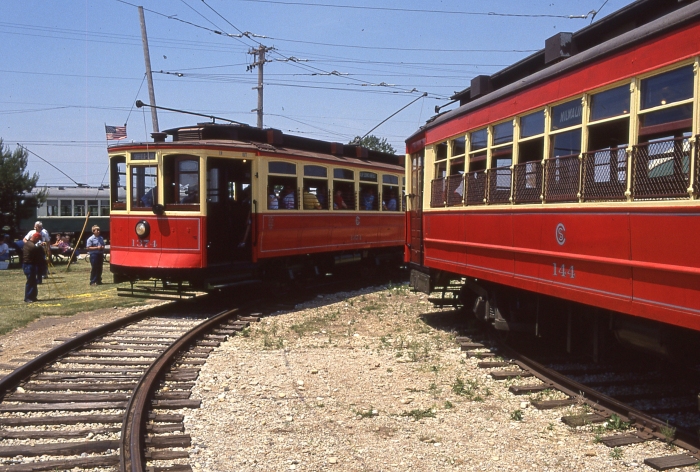
Red Chicago streetcars #144 and #1374 at the Illinois Railway Museum (Author’s photo)
It’s a miracle that any additional cars were saved. You can read the story of how this did in fact happen on the excellent Hicks Car Works blog.
I was just three years old when the last Chicago streetcar ran on that fateful day June 21, 1958, but at least my father had the foresight to make sure I rode one of the PCCs on the south side before the end. By this time, the north end of Clark-Wentworth had already been converted to bus, and streetcars had to turn at Kinzie.
Between 1954 and 1958, there were a number of Red Car fantrips on the CTA, sponsored by CERA and other contemporary organizations. CERA ran three and hosted the final such trip on May 25, 1958. Often, these trips also included a PCC car. The Illini Railroad Club ran two such trips, around Christmas time in both 1956 and 1957. Information on all 206 CERA fantrips from 1938 to 2012 will be included in our upcoming publication Trolley Sparks Special #1.
The curious renumbering in our first photo requires an explanation from longtime CERA member George Foelschow. This was on the December 1956 sojourn. Apparently, trip organizer Maury Klebolt had advertised they were going to use 144, and when they ended up with 225 instead, he didn’t want to disappoint anyone. So a few swatches of oilcloth were painted red and numbered 144, and were placed over the actual numbers.
The Illini fantrip using car 225 renumbered for the day as 144 was held on a December Sunday in 1956. (It was rather silly to “renumber” 225 for one day since most fans were happy to ride a red car, any car, but that was a quirk of Maurice Klebolt of Illini Railroad Club.) I saved one of the oilcloth 144 signs and it hung in my childhood bedroom in Elgin for many years as a memento. It was lost when the house and most contents sold after my parents died and I was living in San Diego.
The day after the trip the Sun-Times had a front page story illustrated with a photo of the car on Dearborn Street near Washington Street with me in a prominent place in the car’s front window. You can see that the 144 tag was a slightly lighter shade of red. The PCC car in the photo was also part of the charter since this was the period of weekend bus substitution. Many, if not most, of the riders were CERA members, though I can name only two besides myself. I am in the car’s right front window against the corner post. Dick Kunz is two persons to my right waving his ungloved hand. Bob Heinlein is at the rear front door wearing a camera bag. I don’t remember if Jeff Wien was on that trip.
Jeff Wien writes:
These black & white pics (3, 4 and 5) were taken on Sunday, December 29, 1957 on the first fantrip that I ever attended at the age of 16. The trip only operated on Clark-Wentworth. I have 8mm color movies of the fantrip as well as other Red Car fantrips which have been digitized. It would only have gone to the Loop (Clark-Kinzie) because Clark Street was converted to bus on September 6, 1957. Red Car movies of various fantrips are covered in my Chicago Streetcar Memories DVD.
Along the way, regular transit riders tried to board the cars, seemingly oblivious to the fact they’d been taken out of service for a few years. That is a testament to how the Big Red Cars were ingrained into the city’s consciousness, during the heyday of CSL, the Chicago Surface Lines, a predecessor of the CTA. Jeff says people back then were often incredulous when he told them he was taking photos and movies of streetcars. They could not understand why anyone would do that, and some even had a “good riddance” attitude about the demise of Chicago trolleys.
But we do not write this blog for any of those people. Now the pendulum has swung the other way, first in the guise of “light rail,” whatever that means, but we are starting to hear the word “streetcar” creep back into the urban environment, in at least a few and growing number of American cities.
Jeff recalls that Maurice Klebolt’s Illini Railroad club eventually fell by the wayside, and he did not see him again until 1982, when he ran into him in San Francisco. While Chicago trolleys bit the dust, Klebolt went on to bigger and better things, as the main “spark plug” behind the San Francisco Trolley Festival. The original idea was to create an alternate tourist attraction, when the famous Cable Cars were taken out of service for a long overdue rehab.
Streetcars were being taken off Market Street as the Muni Metro subway was phased in circa 1980-82. But thanks to Klebolt’s hard work, vision and a bit of “chutzpah,” the historic trolleys soon became an integral part of San Francisco transit, and were eventually extended to Fisherman’s Wharf, paving the way (or more appropriately, unpaving the way) for historic trolley lines in several other US cities.
You can read an appreciation of Maurice Klebolt here.
But given the choice between the New Math and the Old Math, I’ll take the days when 144 equaled 225 every time.
-David Sadowski
You can find more information about the Muni F streetcar line here.
PS- A few words about CTA streetcar abandonment dates. After I wrote this post, I got the following correction from Jeff Wien:
Where did you get that erroneous date of June 22nd? I was on the last car. It pulled in at 6am on Saturday, June 21, 1958. For years, CTA has been putting forth the erroneous date of June 22nd. I don’t know where you got that, but it is wrong.
In the future, I would suggest that you be very careful as to when you quote Streetcar abandonment dates. A number of years ago I learned that the CTA regarded the official conversion dates as taking effect on Sundays. However, that was often not the case because in most of the streetcar abandonments that involved the operation of two man cars, the Saturday prior to the Sunday official conversion date was the real end of streetcar service. If a streetcar line was operated with one man cars, it probably ran streetcars 7 days a week. However, if two man cars were operated, they only ran on weekdays with weekend bus operations. Current CTA staff haven’t a clue as to what went on 50 years ago with weekend bus operations, and because they only know that official route changes are made effective on Sundays, they conclude that the streetcars were withdrawn on Sundays rather than Saturdays.
The Last Chicago Streetcar is a good example of their doctrinaire thinking about route changes. The last car operated on the morning of June 21st which was a Saturday morning. Weekend bus operation began immediately after the Last Car operated. However, the official conversion of the route was effective on Sunday,June 22nd. So, you can see how a current era CTA employee, basically unfamiliar with the history of the Authority, would conclude that the last streetcar ran in the early morning of Sunday, June 22nd. Since I rode and photographed the Last Chicago Streetcar in person, I can refute the revisionists view of streetcar abandonments. I don’t suppose that there are many of us who understand what I have described.
I’ve changed the date in the text to the correct June 21, 1958.
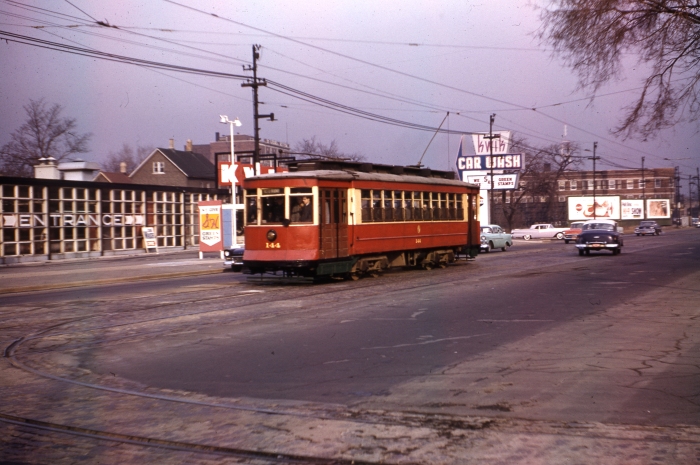
CTA Red Pullman 144 on a fantrip in December 1957. (Author’s collection)

Car 225 on a fantrip (probably February 10, 1957). (Photographer unknown)